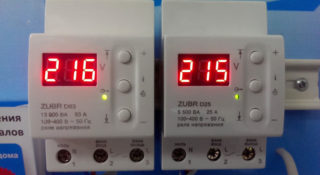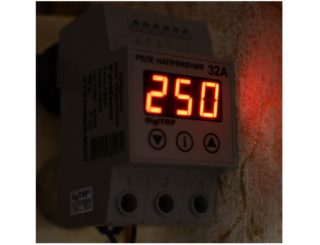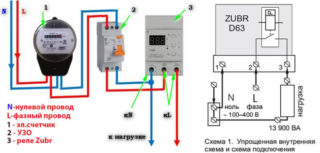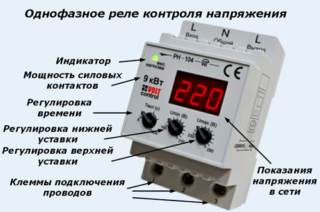A 1-phase voltage control relay is used to protect household appliances from voltage surges in the home electrical network. In case of an emergency, this device instantly disconnects the apartment or a separate load from the power circuits, and after the restoration of normal power, it automatically turns on again. There are two known versions of protective relays of this class, one of which is represented by devices with an automatic time delay. The second models have a simpler design, setting the delay time in them is done manually.
General device and features of work

According to the method of installation in the serviced line, the single-phase voltage relay also has two versions. One of the varieties is made in the form of a remote device that is connected to a regular outlet, and the other is similar to a module mounted on a DIN rail of an input distribution board.
Any single-phase voltage monitoring relay, regardless of its type, includes the following mandatory components:
- An electronic module through which the lower and upper limits of the device are set and controlled.
- Control signal forming unit.
- An executive element in the form of a relay that turns off the PH when the voltage exceeds the permissible limit (setting).
When the voltage in the home network rises or falls to one of the limit values, the electronic module generates a signal that supplies power to the executive relay. The latter works and removes the voltage from the line, reliably protecting the electrical appliances connected to the sockets from damage by high potential.
Advantages of installing a single-phase LV

The need to use voltage relays in apartments and private houses arises for a number of reasons, the most important of which is the desire to protect household appliances connected to the network. In addition, it saves the machines located in the switchboard from overloads.
Usually, a protective device is installed after the electricity meter, but in some cases, with a special permit, it is allowed to connect it before it. With this option of switching on, the PH provides protection for an expensive energy meter, preventing unnecessary expenses for the purchase of a new one.
The single-phase overvoltage relay, in addition to automatic overload protection, allows you to manually set the operation thresholds and visually observe the set values on the display screen. The values of the voltages acting at the output and input of the protective device are also displayed here.
Instrument specifications
- operating voltage in the network (220 volts);
- rated load current;
- lower and upper limits of overload operation;
- delay time before turning on the machine again.
In various types of LV, the rated operating current ranges from 10 to 63 Amperes. The last figure - taking into account the magnetic starter, which is installed additionally. Particularly noteworthy is the second parameter, which varies over a wide range - typical frames - from 210 to 270 volts.The manual delay time for different models is selectable from 1 second to 10 minutes.
The characteristics of the voltage relay connected to the outlet practically do not differ from the parameters of stationary protective devices. Their only difference is that the value of the switched power is limited to 3.6 kW - just over 10 Amperes in current. The use in this case of a magnetic starter with contactors is out of the question - there is simply nowhere to put it.
Connection diagram

Before connecting a single-phase voltage relay to a DIN rail, it is advisable to carefully study the internal structure of the electrical cabinet. Usually, these devices are switched on after the electric meter in the break of the phase and neutral wires. With such a choice of the installation site, the LV will cut off exactly the "phase" together with the neutral supplied through the cable. Only in this way is it possible to achieve its reliable operation in the event of strong voltage drops.
In practice, two well-known schemes for switching single-phase relays to the consumption line are used:
- with direct connection to the load;
- with the connection of power equipment through the contactors included in the magnetic starter.
According to the PUE, parallel connection of several protection devices is allowed, to each of which a separate group of loads can be connected.
When arranging an electrical panel in an apartment or a country house, they usually resort to the first of the options considered. However, if it is planned to install powerful equipment in the load circuits - a three-phase pump, for example, or a heating boiler - you will have to resort to the second method of switching on. In this case, additional power circuits will be required, the commutation of which is carried out indirectly through the coil of the electromagnetic starter.
A good result in this situation can be achieved through the use of a special three-phase LV, designed to work in 380 Volt power circuits.
Choosing a protective device

Before choosing a protective device of one type or another, it is important to determine its operating parameters, which are optimal for specific conditions. If the user is concerned about the safety of expensive household models of a washing machine or an imported refrigerator, it is wiser to purchase a sample of the "socket-plug" type.
This choice is justified only on condition that all other equipment is already reliably protected by the stabilizer. In this case, the installation of a collective relay in the electrical panel will be unnecessary and will lead to unnecessary costs. The plug-and-socket option is more suitable for city dwellers who have decided to save money on the LV installation, since a local electrician will need to be invited to install it. When calculating the possible costs, it is necessary to understand that the purchase of several devices plugged into the outlet, in any case, will cost more than one stationary launch vehicle.
If the user does not have a stabilizer, as well as if the owner of the apartment wishes to reliably protect household equipment, it is wiser and cheaper to choose a device that is installed on a DIN rail. When several voltage relays are connected in parallel, the possibility of damage to expensive equipment is practically excluded. In addition, these devices can be installed in private households, providing voltage control in a three-phase network (one for each phase).
The choice of the voltage relay connection scheme is determined by the conditions of its operation in the place of the proposed installation. When selecting it, one should take into account the values of the currents in the load, which can reach the limiting values. In this case, it is not allowed to connect the relay directly to the serviced circuit according to the PUE. An additional element will have to be introduced into the circuit - an electromagnetic starter, the contactors of which can withstand significant current loads.









